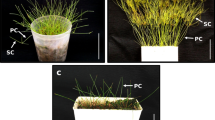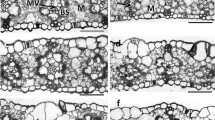Abstract
Main conclusion
Gibberellic acid induces photosynthetic tissues with non-Kranz anatomy and C4-like biochemical traits in terrestrial-form plants of Eleocharis vivipara. This suggests that the structural and biochemical traits are independently regulated.
Abstract
The amphibious leafless sedge, Eleocharis vivipara Link, develops culms (photosynthetic organs) with C4-like traits and Kranz anatomy under terrestrial conditions, and C3 traits and non-Kranz anatomy under submerged conditions. The conversion from C3 mode to C4-like mode in E. vivipara is reportedly mediated by abscisic acid. Here, we investigated the effects of gibberellic acid (GA) on the differentiation of anatomical and photosynthetic traits because GA is involved in heterophylly in aquatic plants. When 100 µM GA was sprayed on terrestrial plants, the newly developed culms had non-Kranz anatomy in the basal part and Kranz-like anatomy in the upper part. In the basal part, the mesophyll cells were well developed, whereas the Kranz (bundle sheath) cells were reduced and contained few chloroplasts and mitochondria. Stomatal frequency was lower in the basal part than in the upper part. Nevertheless, these tissues had abundant accumulation and high activities of C4 photosynthetic enzymes and had C4-like δ13C values, as seen in the culms of the terrestrial form. When submerged plants were grown under water containing GA-biosynthesis inhibitors (uniconazole or paclobutrazol), the new culms had Kranz anatomy. The culms developed under paclobutrazol had the C3 pattern of cellular accumulation of photosynthetic enzymes. These data suggest that GA induces production of photosynthetic tissues with non-Kranz anatomy in terrestrial plants of E. vivipara, without concomitant expression of C3 biochemical traits. The data also suggest that the differentiation of C4 structural and biochemical traits is regulated independently.






Similar content being viewed by others
References
Agarie S, Kai M, Takatsuji H, Ueno O (1997) Expression of C3 and C4 photosynthetic characteristics in the amphibious plant Eleocharis vivipara: structure and analysis of the expression of isogenes for pyruvate, orthophosphate dikinase. Plant Mol Biol 34:363–369
Agarie S, Kai M, Takatsuji H, Ueno O (2002) Environmental and hormonal regulation of gene expression of C4 photosynthetic enzymes in the amphibious sedge Eleocharis vivipara. Plant Sci 163:571–580
Bowes G (2011) Single cell C4 photosynthesis in aquatic plants. In: Raghavendra AS, Sage RF (eds) C4 photosynthesis and related CO2 concentrating mechanisms. Springer, Dordrecht, pp 63–80
Cernusak LA, Ubierna N, Winter K, Holtum JAM, Marshall JD, Farquhar GD (2013) Environmental and physiological determinants of carbon isotope discrimination in terrestrial plants. New Phytol 200:950–965
Chen T, Ye R, Fan X, Li X, Lin Y (2011) Identification of C4 photosynthesis metabolism and regulatory-associated genes in Eleocharis baldwinii by SSH. Photosynth Res 108:157–170
Chen T, Zhu X-G, Lin Y (2014) Major alterations in transcript profiles between C3–C4 and C4 photosynthesis of an amphibious Eleocharis baldwinii. Plant Mol Biol 86:93–110
Christin PA, Besnard G, Samaritani E, Duvall MR, Hodkinson TR, Savolainen V, Salamin N (2008) Oligocene CO2 decline promoted C4 photosynthesis in grasses. Curr Biol 18:37–43
Chu C, Dai Z, Ku MSB, Edwards GE (1990) Induction of crassulacean acid metabolism in the facultative halophyte Mesembryanthemum crystallinum by abscisic acid. Plant Physiol 93:1253–1260
Cushman JC (2001) Crassulacean acid metabolism. A plastic photosynthetic adaptation to arid environments. Plant Physiol 127:1439–1448
Deschamp PA, Cooke TJ (1984) Causal mechanisms of leaf dimorphism in the aquatic angiosperm Callitriche heterophylla. Amer J Bot 71:319–329
Edwards GE, Voznesenskaya EV (2011) C4 photosynthesis: Kranz forms and single-cell C4 in terrestrial plants. In: Raghavendra AS, Sage RF (eds) C4 photosynthesis and related CO2 concentrating mechanisms. Springer, Dordrecht, pp 29–61
Ehleringer JR, Osmond CB (1989) Stable isotopes. In: Pearcy PW, Ehleringer JR, Mooney HA, Randel PW (eds) Plant physiological ecology. Chapman & Hall, London, pp 281–300
Ermakova M, Danila FR, Furbank RT, von Caemmerer S (2020) On the road to C4 rice: advances and perspectives. Plant J 101:940–950
Goliber TE, Feldman LJ (1989) Osmotic stress, endogenous abscisic acid and the control of leaf morphology in Hippuris vulgaris L. Plant Cell Environ 12:163–171
Guralnick LJ, Ku MSB, Edwards GE, Strand D, Hockema B, Earnest J (2001) Induction of PEP carboxylase and crassulacean acid metabolism by gibberellic acid in Mesembryanthemum crystallinum. Plant Cell Physiol 42:236–239
Harada D, Yamato KT, Izui K, Akita M (2018) De novo short read assembly and functional annotation of Eleocharis vivipara, a C3/C4 interconvertible sedge plant. Environ Cont Biol 56:81–87
Hatakeyama Y, Ueno O (2016) Intracellular position of mitochondria and chloroplasts in bundle sheath and mesophyll cells of C3 grasses in relation to photorespiratory CO2 loss. Plant Prod Sci 19:540–551
Hatch MD (1987) C4 photosynthesis: a unique blend of modified biochemistry, anatomy and ultrastructure. Biochim Biophys Acta 895:81–106
Hsu TC, Liu HC, Wang JS, Chen RW, Wang YC, Lin BL (2001) Early genes responsive to abscisic acid during heterophyllous induction in Marsilea quadrifolia. Plant Mol Biol 47:703–715
Inaga S, Katsumoto T, Tanaka K, Kameie T, Nakane H, Naguro T (2007) Platinum blue as an alternative to uranyl acetate for staining in transmission electron microscopy. Arch Histol Cytol 70:43–49
Kane ME, Albert LS (1982) Environmental and growth regulator effects on heterophylly and growth of Proserpinaca intermedia (Haloragaceae). Aquat Bot 13:73–85
Kane ME, Albert LS (1987) Integrative regulation of leaf morphogenesis by gibberellic and abscisic acids in the aquatic angiosperm Proserpinaca palustris L. Aquat Bot 28:89–96
Kataoka K, Sakakibara T, Nishikawa K, Kusumi K, Yazawa S (2008) Seed formation is affected by uniconazole, an inhibitor of gibberellin biosynthesis, in a parthenocarpic cultivar Severianin of tomato (Lycopersicon esculentum Mill.). J Jpn Soc Hort Sci 77:283–288
Kuwabara A, Ikegami K, Toshiba T, Nagata T (2003) Effects of ethylene and abscisic acid upon heterophylly in Ludwigia arcuata (Onagraceae). Planta 217:880–887
Langdale JA (2011) C4 cycles: past, present, and future research on C4 photosynthesis. Plant Cell 23:3879–3892
Leegood RC (2013) Strategies for engineering C4 photosynthesis. J Plant Physiol 170:378–388
Lenton JR, Appleford NEJ, Temple-Smith KE (1994) Growth retardant activity of paclobutrazol enantiomers in wheat seedlings. Plant Growth Reg 15:281–291
Li G, Hu S, Hou H, Kimura S (2019) Heterophylly: phenotypic plasticity of leaf shape in aquatic and amphibious plants. Plants 8:420
Maberly SC, Spence DHN (1989) Photosynthesis and photorespiration in freshwater organisms: amphibious plants. Aquat Bot 34:267–286
McComb AJ (1965) The control of elongation in Callitriche shoots by environment and gibberellic acid. Ann Bot 29:445–458
Minorsky PV (2003) Heterophylly in aquatic plants. Plant Physiol 133:1671–1672
Mommer L, Visser EJW (2005) Underwater photosynthesis in flooded terrestrial plants: a matter of leaf plasticity. Ann Bot 96:581–589
Nakayama H, Nakayama N, Seiki S, Kojima M, Sakakibara H, Sinha N, Kimura S (2014) Regulation of the KNOX-GA gene module induces heterophyllic alteration in North American lake cress. Plant Cell 26:4733–4748
Nelson T (2011) The grass leaf developmental gradient as a platform for a systems understanding of the anatomical specialization of C4 leaves. J Exp Bot 62:3039–3048
Pick TR, Bräutigam A, Schlüter U, Denton AK, Colmsee C, Scholz U, Fahnenstich H, Pieruschka R, Rascher U, Sonnewald U, Weber APM (2011) Systems analysis of a maize leaf developmental gradient redefines the current C4 model and provides candidates for regulation. Plant Cell 23:4208–4220
Porra RJ, Thompson WA, Kriedemannet PE (1989) Determination of accurate extension coefficients and simultaneous equations for assaying chlorophylls a and b extracted with four different solvents: verification of the concentration of chlorophyll standards by atomic absorption spectroscopy. Biochim Biophys Acta 975:384–394
Roth R, Hall LN, Brutnell TP, Langdale JA (1996) bundle sheath defective 2, a mutation that disrupts the coordinated development of bundle sheath and mesophyll cells in the maize leaf. Plant Cell 8:915–927
Sage RF, Sage TL, Kocacinar F (2012) Photorespiration and the evolution of C4 photosynthesis. Annu Rev Plant Biol 63:19–47
Schlüter U, Weber APM (2020) Regulation and evolution of C4 photosynthesis. Annu Rev Plant Biol 71:183–215
Schuler M, Mantegazza O, Weber APM (2016) Engineering C4 photosynthesis into C3 chassis in the synthetic biology age. Plant J 67:51–65
Sedelnikova OV, Hughes TE, Langdale JA (2018) Understanding the genetic basis of C4 Kranz anatomy with a view to engineering C3 crops. Annu Rev Genet 52:249–270
Slewinski TL, Anderson AA, Zhang C, Turgeon R (2012) Scarecrow plays a role in establishing Kranz anatomy in maize leaves. Plant Cell Physiol 53:2030–2037
Slewinski TL, Anderson AA, Price S, Withee JR, Gallagher K, Turgeon R (2014) Short-Root 1 plays a role in the development of vascular tissue and Kranz anatomy in maize leaves. Mol Plant 7:1388–1392
Tashima M, Yabiku T, Ueno O (2021) Coleataenia prionitis, a C4-like species in the Poaceae. Photosynth Res 147:211–227
Taybi T, Cushman JC, Borland AM (2002) Environmental, hormonal and circadian regulation of crassulacean acid metabolism expression. Funct Plant Biol 29:669–678
Uchino A, Sentoku N, Nemoto K, Ishii R, Samejima M, Matsuoka M (1998) C4-type gene expression is not directly dependent on Kranz anatomy in an amphibious sedge Eleocharis vivipara Link. Plant J 14:565–572
Ueno O (1996a) Structural characterization of photosynthetic cells in an amphibious sedge, Eleocharis vivipara, in relation to C3 and C4 metabolism. Planta 199:382–393
Ueno O (1996b) Immunocytochemical localization of enzymes involved in the C3 and C4 pathways in the photosynthetic cells of an amphibious sedge, Eleocharis vivipara. Planta 199:394–403
Ueno O (1998) Induction of Kranz anatomy and C4-like biochemical characteristics in a submerged amphibious plant by abscisic acid. Plant Cell 10:571–583
Ueno O (2001) Environmental regulation of C3 and C4 differentiation in the amphibious sedge Eleocharis vivipara. Plant Physiol 127:1524–1532
Ueno O (2004) Environmental regulation of photosynthetic metabolism in the amphibious sedge Eleocharis baldwinii and comparisons with related species. Plant Cell Environ 27:627–639
Ueno O, Ishimaru K (2002) Effects of an inhibitor of phosphoenolpyruvate carboxylase on photosynthesis of the terrestrial forms of amphibious Eleocharis species. Photosynth Res 71:265–272
Ueno O, Samejima M, Muto S, Miyachi S (1988) Photosynthetic characteristics of an amphibious plant, Eleocharis vivipara: expression of C4 and C3 modes in contrasting environments. Proc Natl Acad Sci USA 85:6733–6737
Wakayama M, Ueno O, Ohnishi J (2003) Photosynthetic enzyme accumulation during leaf development of Arundinella hirta, a C4 grass having Kranz cells not associated with veins. Plant Cell Physiol 44:1330–1340
Wanke D (2011) The ABA-mediated switch between submersed and emersed life-styles in aquatic macrophytes. J Plant Res 124:467–475
Winter K (2019) Ecophysiology of constitutive and facultative CAM photosynthesis. J Exp Bot 70:6495–6508
Yorimitsu Y, Kadosono A, Hatakeyama Y, Yabiku T, Ueno O (2019) Transition from C3 to proto-Kranz to C3–C4 intermediate type in the genus Chenopodium (Chenopodiaceae). J Plant Res 132:839–855
Acknowledgements
We thank Prof. N. Furuya, Faculty of Agriculture, Kyushu University for use of an electron microscope and Dr. Y. Hatakeyama, Faculty of Agriculture, Ehime University for his help in preparation of the figures. Part of this study was supported by a grant-in-aid from the Ministry of Agriculture, Forestry, and Fisheries of Japan (Bio-Design Project) to OU and a grant from the Academic Challenge Program of Kyushu University to YS.
Author information
Authors and Affiliations
Corresponding author
Ethics declarations
Conflict of interest
The authors declare that this study was conducted in the absence of any commercial relationships that could lead to any potential conflict of interest.
Additional information
Communicated by Anastasios Melis.
Publisher's Note
Springer Nature remains neutral with regard to jurisdictional claims in published maps and institutional affiliations.
Supplementary Information
Below is the link to the electronic supplementary material.
Rights and permissions
About this article
Cite this article
Suizu, Y., Takao, K. & Ueno, O. Gibberellic acid induces non-Kranz anatomy with C4-like biochemical traits in the amphibious sedge Eleocharis vivipara. Planta 254, 10 (2021). https://doi.org/10.1007/s00425-021-03662-9
Received:
Accepted:
Published:
DOI: https://doi.org/10.1007/s00425-021-03662-9




